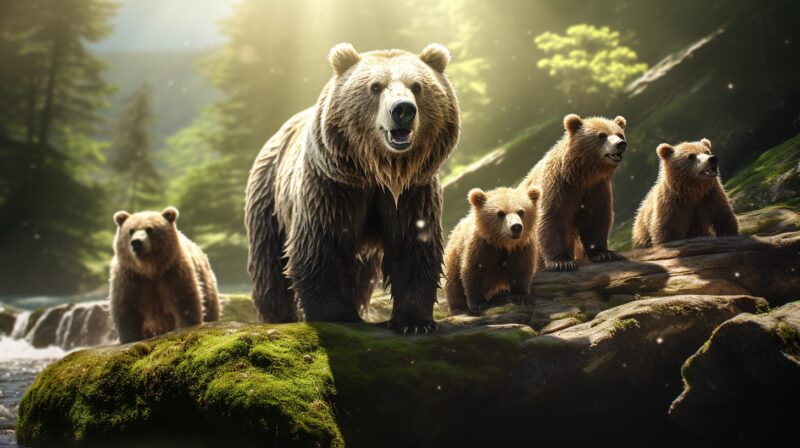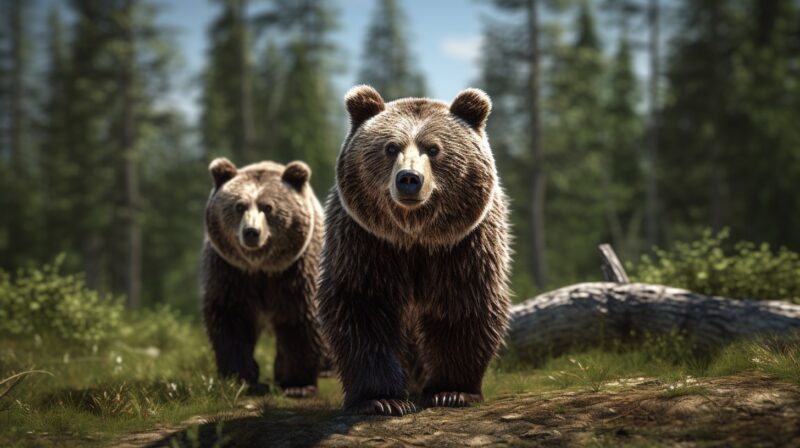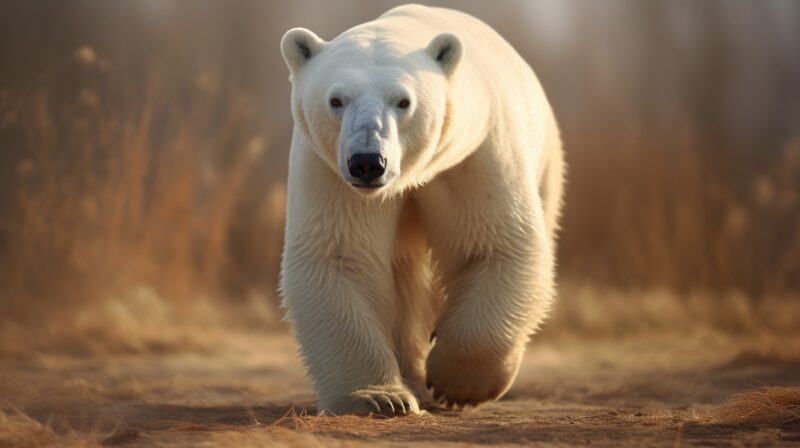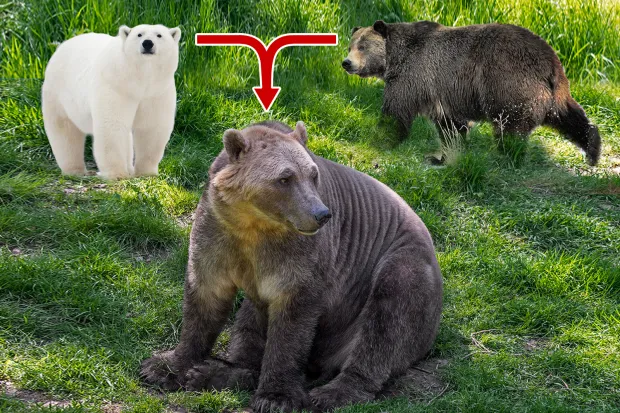The natural world is a vast and intricate tapestry of life, where the interplay of different species and environments often leads to fascinating phenomena. One such phenomenon is the emergence of hybrid species, and in this context, the Pizzly and Grolar bears stand out as subjects of great interest and study.
These creatures are the offspring of polar bears and grizzly bears, and their existence raises many questions about ecology, genetics, and climate change. This article delves into the world of Pizzly and Grolar bears, exploring their origins, characteristics, habitats, and the implications of their existence in our changing world. 🐻
Key Takeaways
- Hybrid Species: Pizzly and Grolar bears are unique hybrids of polar and grizzly bears, primarily formed due to climate change impacts.
- Physical Characteristics: They exhibit mixed features from both parent species, such as varied fur colors and large paws.
- Conservation Challenges: Their existence poses challenges for conservation efforts, highlighting the need to address climate change effects on wildlife.
- Ecological Impact: The hybrids potentially impact Arctic ecosystems, altering traditional wildlife roles and behaviors.
- Significance: These bears symbolize the adaptability of nature amidst environmental changes, emphasizing the urgency of ecological conservation.
Hybridization
Hybridization, in biological terms, refers to the process where two different species mate and produce offspring. This can occur in nature under certain circumstances, and the resulting hybrids often display characteristics of both parent species. The Pizzly and Grolar bears are prime examples of natural hybridization.
The terms ‘Pizzly’ and ‘Grolar’ are portmanteaus of polar bears (Ursus maritimus) and grizzly bears (Ursus arctos horribilis), indicating their mixed lineage. The term ‘Pizzly’ is generally used when the polar bear is the sire (father), and ‘Grolar’ when the grizzly bear is the sire.
Origins and Discovery

The existence of Pizzly and Grolar bears was not widely recognized until the early 21st century. The first confirmed hybrid was discovered in the wild in 2006, when a bear shot in Canada’s Arctic displayed physical characteristics of both polar and grizzly bears. DNA tests confirmed its hybrid status, marking a significant moment in our understanding of these species’ interactions.
The emergence of Pizzly and Grolar bears, the hybrids of polar and grizzly bears, is a phenomenon primarily attributed to environmental changes, particularly those associated with climate change. The key factors leading to their existence include:
- Habitat Overlap Due to Climate Change: One of the most significant drivers behind the existence of Pizzly and Grolar bears is the shifting boundaries of their respective habitats. Polar bears are traditionally sea-ice dwellers, using the ice platforms for hunting seals. Grizzly bears, on the other hand, are more commonly found in forested areas and open landscapes. However, with the warming climate, sea ice is melting at unprecedented rates. This environmental change forces polar bears to travel further inland in search of food, where they encounter grizzly bears.
- Increased Interaction Opportunities: As polar bears spend more time on land due to the loss of sea ice, the opportunities for interaction and mating with grizzly bears increase. Such encounters were less common when both species were separated by distinct ecological niches and geographical barriers.
- Survival and Adaptation Mechanisms: Hybridization in wildlife can be seen as a natural adaptation and survival mechanism in response to environmental pressures. In the face of rapid ecological changes, species may resort to alternative survival strategies, including breeding with closely related species. This process can lead to the development of hybrids that may possess a mix of traits making them more adaptable to the changing conditions.
- Reduced Competition and Availability of Mates: In some cases, the diminishing population of one species in a changing habitat can lead to reduced competition for mates within the same species, leading individuals to seek mates from closely related species. This is particularly relevant in areas where one of the parent species is less abundant.
Physical Characteristics
Pizzly and Grolar bears exhibit a blend of physical traits from their parent species. They often have the long necks and lean bodies of polar bears, combined with the humped backs and brown fur of grizzly bears.
The color of their fur can vary from white to brown, and they may have patches of different colors. Their size generally falls between that of the polar and grizzly bears, and they have been noted to have large paws, a trait useful in both swimming and walking on land.
| Feature | Pizzly Bear | Grolar Bear |
|---|---|---|
| Neck | Long (Polar bear trait) | Long (Polar bear trait) |
| Body | Lean (Polar bear trait) | Lean (Polar bear trait) |
| Back | Humped (Grizzly trait) | Humped (Grizzly trait) |
| Fur Color | Varies from white to brown, may have patches | Varies from white to brown, may have patches |
| Size | Between polar and grizzly bear size | Between polar and grizzly bear size |
| Paws | Large (useful for swimming and walking) | Large (useful for swimming and walking) |
Habitat and Behavior
These hybrids are generally found in regions where the territories of polar and grizzly bears overlap, such as the Arctic regions of Canada. The melting of sea ice due to climate change has been a significant factor in this overlap, as polar bears are forced to travel further inland, where they encounter grizzly bears.
In terms of behavior, Pizzly and Grolar bears appear to exhibit a mix of their parents’ habits. They are capable of surviving in both Arctic and sub-Arctic environments. Their diet can range from the primarily meat-based diet of polar bears to the more omnivorous diet of grizzly bears, which includes berries, roots, and other plant materials.
Genetic Implications

The emergence of Pizzly and Grolar bears has significant implications for our understanding of genetics and species evolution. It challenges the traditional notions of species as distinct and unchanging entities. The ability of these two bear species to interbreed and produce fertile offspring suggests a closer genetic relationship than previously thought.
This hybridization also raises questions about the genetic adaptability of species to changing environments. As the climate warms and habitats change, the ability of species to adapt – either through migration, adaptation, or hybridization – becomes critical to their survival.
Conservation and Climate Change
The existence of Pizzly and Grolar bears is intimately tied to the broader issues of conservation and climate change. Their emergence is a direct result of the shifting habitats caused by a warming climate. This brings into focus the impact of human activities on wildlife and ecosystems.
Conservation efforts for polar and grizzly bears need to take into account the potential effects of hybridization. While these hybrids are a natural response to environmental changes, they also represent a potential threat to the genetic distinctiveness of both parent species.
- Genetic Swamping: This occurs when the genes of a more dominant or populous species overwhelm the gene pool of a less common species. In the case of Pizzly and Grolar bears, there is a risk that the genetic traits of grizzly bears, which are generally more numerous, could dilute or overpower the unique genetic makeup of the more vulnerable polar bear population.
- Loss of Specialized Adaptations: Both polar and grizzly bears have evolved specific adaptations to their respective environments. Polar bears are highly specialized for life in Arctic conditions, while grizzly bears are adapted to forested and mountainous areas. Hybridization could lead to a dilution of these specialized adaptations, potentially resulting in hybrids less fit for the specific challenges of either environment.
- Reduced Fitness and Survival Challenges: Hybrids might not inherit the best traits of both parents and could end up with a mix of features that are not ideal for survival in either of the parent species’ habitats. This could lead to lower survival rates or reduced fitness in hybrids compared to their purebred counterparts.
- Altered Behavioral Patterns: Hybrid bears could exhibit behavioral traits that are a mix of both parent species, potentially leading to changes in foraging habits, predator-prey interactions, and other ecological roles. Such changes could have cascading effects on the ecosystems they inhabit.
- Complications in Conservation Efforts: The presence of hybrids complicates conservation strategies aimed at preserving the distinct species. Managing ecosystems to support the distinct needs of polar and grizzly bears becomes more challenging when hybrids are present, potentially diverting resources and focus from conservation of the pure species.
- Challenges in Legal Protection: Often, conservation laws and policies are species-specific. Hybrids like Pizzly and Grolar bears may fall into a legal gray area, lacking the same level of protection as their parent species, which can hinder conservation efforts.
- Public Perception and Prioritization: The novelty and curiosity surrounding hybrids can sometimes overshadow the conservation needs of the parent species. This can lead to a shift in public attention and resources away from the conservation of polar and grizzly bears to the more sensational hybrid species.
- Climate Change Acceleration: As climate change is a driving factor behind the hybridization, the continued existence and potential increase in the population of these hybrids serve as a reminder of the rapidly changing environmental conditions, which pose a broader threat to biodiversity and ecological balance.

FAQs
Can Pizzly and Grolar bears reproduce, and if so, what are their offspring like?
Yes, Pizzly and Grolar bears are capable of reproducing. Their offspring, being second-generation hybrids, display an even more complex mix of traits from the polar and grizzly bear lineages. The long-term viability and characteristics of these second-generation hybrids are a subject of ongoing research, as they offer insights into the genetics and adaptability of bear species.
How do scientists track and study Pizzly and Grolar bear populations in the wild?
Scientists use a combination of methods to track and study these hybrids. This includes DNA analysis from fur or scat samples, which helps in confirming their hybrid status. Additionally, tracking devices such as GPS collars are sometimes used to monitor their movements and behaviors in the wild. Observational studies and camera traps also play a role in gathering data on these elusive animals.
Are Pizzly and Grolar bears recognized as distinct species?
As of now, Pizzly and Grolar bears are not recognized as distinct species. They are considered hybrids of polar and grizzly bears. The classification of species is a complex and evolving field, and the status of these hybrids may be reassessed as more is learned about them.
What impact does the presence of these hybrids have on the local ecosystem?
The impact of Pizzly and Grolar bears on local ecosystems is not fully understood, but they could potentially alter ecological dynamics. For instance, their varied diet and adaptable foraging behaviors might affect the populations of certain prey species. Their presence also indicates changes in the distribution of polar and grizzly bears, which can have cascading effects on the ecosystem.
How do Pizzly and Grolar bears cope with the harsh Arctic environment compared to their parent species?
Pizzly and Grolar bears seem to inherit traits from both parent species that aid in Arctic survival. They have the thick fur and fat reserves of polar bears, which are crucial for warmth, and the muscular build of grizzly bears, which aids in traversing rugged terrain. However, their long-term adaptability to the extreme Arctic environment, especially as it undergoes rapid changes, remains a topic of research.
What role do zoos and wildlife sanctuaries play in the study and conservation of these hybrids?
Zoos and wildlife sanctuaries can play a significant role in the study and conservation of Pizzly and Grolar bears. They offer a controlled environment for detailed study of their behavior, diet, and health. These facilities also serve as educational platforms to raise public awareness about these bears, their unique status, and the broader issues of wildlife conservation and climate change.
Final Words
Pizzly and Grolar bears are more than just a curiosity; they are a symbol of the dynamic and ever-changing nature of life on Earth. Their existence challenges our understanding of species boundaries, offers insights into the impacts of climate change, and raises important questions about conservation and biodiversity.
As we continue to study these remarkable animals, they will undoubtedly provide valuable lessons about adaptation, survival, and the interconnectedness of all life in the face of a rapidly changing world. 🐾








